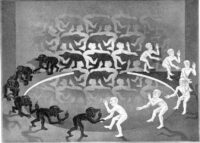In the 1974 book Lives of a Cell, author Lewis Thomas paints a disarmingly sweet portrait of a single cell that all but imparts a charming personality upon a living thing so small it’s microscopic. The life of a single cell, one of 40 trillion in each of our bodies, reflects the drama of human life itself: birth, growth, movement, maturity, reproduction and death.
Molecular biology was just on the verge of unlocking the secrets of DNA, RNA and the genetic code in 1974. In the 36 years since, the genome of human DNA, (over 3 billion base pairs comprised of between 20-25,000 protein coded genes), has been determined. The fruition of 3 billion years of natural evolution, the human genome ecapsulates the sum total of the history of animal life on earth, a genetic encyclopedia of change and transformation.
Scientists, it was announced, have recently constructed and inserted man-made artificial DNA into a bacteria cell and that cell went on to generate proteins produced at the direction of the artificial DNA and to replicate itself. Human evolution is now on the brink of sudden change. None of us can predict the precise nature of that change. What we can be sure of, however, is that at some point man-made artificial genes will make their way into living animals, and eventually to human beings.
It is not without some sense of trepidation that I imagine man-made people, and in time, designer genes. Want a baby with blue skin and pink polkadots? How about hands with six fingers and eyes that glow in the dark? It may sound far-fetched, but given our proven ability to commercialize every significant scientific invention, I think such outcomes are a sure bet.
What’s less certain is what happens when we screw up. By leapfrogging over the drawn-out process of natural selection and inserting man-made genetic characteristics based on market trends and focus groups, we’re moving into uncharted territory. Nature has used an elegant, if uncompromising, methodology for billions of years: mutate, test and keep what works over a long period of time. This fiscal year’s genetic blockbuster carries with it the same risks as any other hot consumer product, and the idea of people designed according to the latest fashion trend is, frankly, horrifying.
There are few major inventions that are put back in the bottle once removed. Science has a penchant for discovery and experiment, even if that means courting disaster. The search for knowledge has produced technological miracles and the machine age is nothing short of magical. Yet tampering with the stuff of life itself makes the risks of nuclear technology seem modest. If we consider the virus and its ability to combine with human DNA in relentless pursuit of successful mutation, it is readily apparent that even a casual mistake might end up polluting both human and non-human species of animal life.
Ironically, Lewis also recounts the biology of mitochondria, the organelle within each animal cell that is essential for energy conversion. Mitochondria have their own DNA, and Lewis traces it back to the plant kingdom. The very cellular structure that gives us life may be the result of a primordial animal-plant combination. We may, in some strange way, be highly evolved cabbages, and if we are not careful, into vegetables we may yet return.




